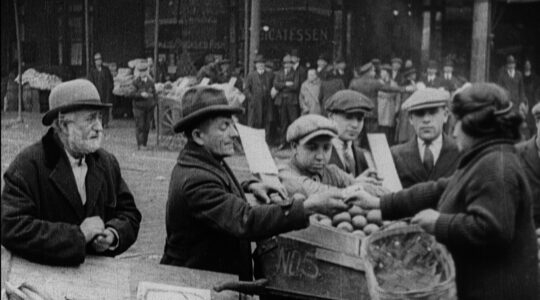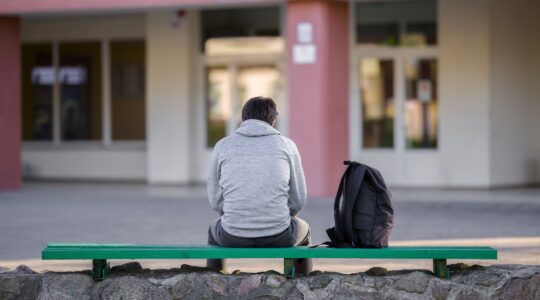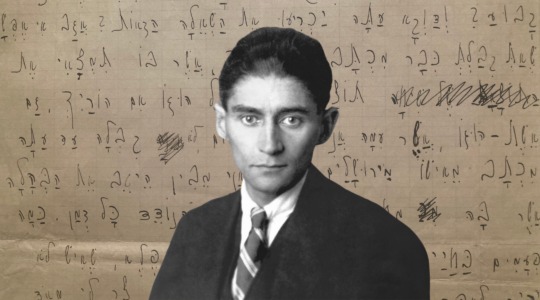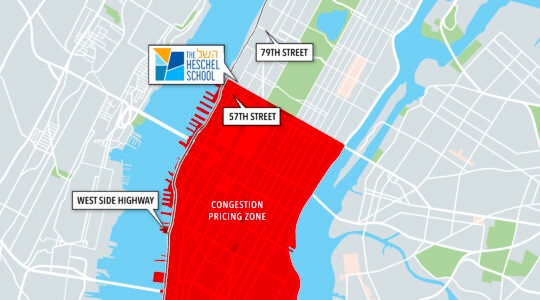One day in the summer of 2000, an archivist in the magnificent medieval cathedral of the northern Spanish town of Tarazona found that the cover of a 14th-century book in the church’s collection of manuscripts had been ripped. Examining the book closely, he discovered that inside the cover was an until-then undetected document written in Hebrew that had apparently been inserted into the cover hundreds of years ago to help hold the book together. The Hebrew text was a synagogue document from Tarazona’s long-lost Jewish community, which like the rest of Spanish Jewry, was expelled from the country in 1492.
Excited by the discovery, the archivist informed Javier Bona, a local archaeologist who only months earlier had created an organization known as The Association of the Friends of Jewish Culture-Moshe De Portella, named for a Jew from Tarazona who was a legendary financier for the King of Aragon during the 13th century. Spurred on by Bona, a team of archivists peeled back the covers of a number of other venerable volumes preserved in the cathedral, and found to their great excitement that these books too had been held together by inserting inside their covers Jewish documents which obviously had been confiscated by the local Catholic Church.
In the months since, the archivists have discovered some 60 of these medieval Hebrew documents; an assortment of legal deeds and religious writings, including one that is written in Arabic with Hebrew lettering. These unique documents are proving invaluable to Bona and other members of his association in fleshing out the life of the long-disappeared Jewish community of the town.
Mention the glory of Spanish Jewry in the days before the Inquisition and what comes immediately to mind are the southern cities of Cordoba and Granada, where giants of Jewish history like Moses Maimonides and Yehuda Halevi lived and wrote, and where highly literate Jewish communities helped the Muslim leaders of Spain create a glorious civilization at a time when Christian Europe was slumbering in the Dark Ages. Another city where Jewish life flourished before the Inquisition is Toledo, the beautiful former capital of Castille, located near Madrid in central Spain, which, like Cordoba and Granada, is today much visited by Jewish tourists from around the world.
But until now, there has been almost no awareness in the Jewish world of the Judaic legacy of Tarazona and other ancient towns in the northern kingdom of Aragon, whose King Ferdinand married Castilian Queen Isabella and united their kingdoms to form modern Spain.
That ignorance and neglect are expected to come to an end this summer when Tarazona, a gemlike medieval town of 12,000 set on a verdant plain below towering Mt. Moncayo about halfway between the Mediterranean and the Atlantic, hosts a festival called “The Return of Sepharad to Tarazona. The festival, to be held on July 27-28, will be attended by the Israeli ambassador to Spain, Aragonese and Spanish government officials and Jewish dignitaries from around the world. The two-day event will feature an exhibition of the recently discovered Hebrew manuscripts of the town at the venerable palace of the bishop of the city; the presentation of a new book on the history of Tarazona Jewry; a celebration of the cuisine of the Jews of Spain and a concert featuring medieval Sephardic music. (For more information check the website, http://portella.pvirt.com.)
There will also be walking tours of the Juderia (Jewish Quarter), an area of the old town which has retained its name among the local population even though there have been no Jews living there in 500 years. Expected to take part in the festivities will be Israeli and Palestinian children who will attend a peace camp in the town this summer under the auspices of the government of Aragon and Encounter, an on-line community for Jewish-Arab reconciliation.
The Jewish renaissance in Tarazona is likely to prove only the tip of the iceberg in a coming revival of interest in and knowledge about the long forgotten Jews of Aragon. According to Bona, “Like Tarazona, virtually every old city in Aragon has a Juderia, but until recently, no one seemed to care who those Jews had been and what their lives had been like. We were motivated to investigate the story of the Jews of Tarazona not simply out of academic interest, but from a conviction that it is time to do justice, however late, to Sepharad by recovering the memory of the Jews of Tarazona. We must rescue a corner of the past for our common future.”
Bona said there is evidence of Jewish life in Tarazona and neighboring towns going back to Roman times. He noted that the Jews of Tarazona had a close relationship with the kings and queens of Aragon, going back to Moshe De Portella in the 13th century, who was the equivalent of the Rothschilds in his era. Around 1370, after Tarazona had nearly been destroyed in a ruinous war between Castille and Aragon, the Jews of Tarazona financed the rebuilding of the city’s walls. When a massive pogrom against the Jews swept across Spain in 1391, Tarazona was the only town in which the mayor issued an edict — the text of which still can be found in the municipal archives — promising stern punishment against anyone who committed violence against Jews. The Jewish community of Tarazona remained intact until 1492, when after the union of Castile and Aragon, King Ferdinand and Queen Isabella decreed the expulsion of the Jews from Spain.
Visitors to the Juderia today will find a rabbit’s warren of narrow alleys and Spanish and Moorish style buildings, most of them still lived in, which has changed little with the passage of centuries. Several of the buildings, which are built on top of natural rock formations, are known as the “hanging houses.” Below them are caves, which also evidently served as rooms in the homes of residents of the Jewish Quarter. In the past year, through use of old maps and documents discovered in the Cathedral and the Bishop’s Palace, Bona has managed to figure out the function of many of these buildings during the 13th and 14th century when the Juderia was at its height.
In the center of the quarter is a large ruined dwelling that retains an ornate door from medieval times, which apparently served as a Talmud Torah, which has clear evidence of a mikveh in the basement. Bona said that the Association of the Friends of Jewish Culture of Tarazona is now looking for the funding necessary to do a full restoration of this house, in which it plans to place a museum devoted to the life of the Jews of Tarazona. Nearby are buildings that have been identified by Bona as a synagogue and a butcher shop.
The Juderia is a three-minute walk from Tarazona’s ornate city hall, which has a magnificent frieze on its exterior depicting the coronation of Emperor Charles V of Spain and Germany during the 16th century. The Cathedral and other venerable buildings of Tarazona are built in the distinctive “mudejar style,” a delicate lace-like form of brickwork which was created by Muslim master artisans in Aragon and other provinces even after the re-conquest of those areas by the Christians.
Another unique sight in the town is the only inhabited bullring in the world, a creaky-looking circular structure that today contains the apartments of families who hang their laundry from balconies from which audiences cheer the matadors.
People in Tarazona seem gratified that they are finally beginning the process of healing a 500-year-old wound by celebrating the Jewish heritage of the town. They are also evidently excited by the possibility that they will soon see a surge of Jewish visitors, which would give a needed economic boost to a town that despite its beauty and antiquity, has hitherto been far from the beaten tourist track. “We look forward to welcoming home to Tarazona today the descendants of the Jews forced to leave here in 1492,” said the town’s mayor, Javier Calavia. “That will be a kind of symbolic closing of the circle, and will open us to the world in a way we have not been before.”
Officials of the Aragonese government in the capital city of Zaragoza, an hour’s drive from Tarazona, point out that their own city of 700,000 also has a rich history of harmony between Christians, Jews and Muslims and has much tourist interest as well. Zaragoza’s jewel in the crown is clearly the Aljaferia, a sprawling castle and fortress built by the Muslim conquerers of Zaragoza in the 10th century that later became the palace of the Christian kings of Aragon. Today the castle houses the Cortes (Parliament) of Aragon.
Jose Maria Mur, president of the Cortes, said, “We hope the Aljaferia will serve as a place of encounter for the former Jewish and Muslim communities of Aragon. Let them come home and reconnect to their Aragonese roots,” Juan Carlos Trillo, Aragon’s ambassador to the central government in Madrid, remarked. “We are gratified that Aragon is finally coming to terms with the terrible injustice of the expulsion of our Jews, which not only devastated their lives, but did grievous damage to Aragon itself and the rest of Spain.”
Manuel Blasco, director of Zaragoza 2008, an effort by the city to win the right to host the World Expo of 2008, noted that Zaragoza has applied for a United Nations designation as a “City of Peace.”
“Having been the scene of religious persecution in the past,” he said, “we in Aragon hope to build a brighter future by making a significant contribution to peacemaking and conflict resolution in the years ahead.”
The New York Jewish Week brings you the stories behind the headlines, keeping you connected to Jewish life in New York. Help sustain the reporting you trust by donating today.




